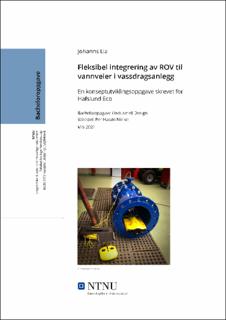| dc.contributor.advisor | Ninive, Per Harald | |
| dc.contributor.author | Lia, Johannes | |
| dc.date.accessioned | 2021-09-24T19:23:57Z | |
| dc.date.available | 2021-09-24T19:23:57Z | |
| dc.date.issued | 2021 | |
| dc.identifier | no.ntnu:inspera:77257744:81558249 | |
| dc.identifier.uri | https://hdl.handle.net/11250/2782296 | |
| dc.description.abstract | Selv om vannkraft står sterkt i Norge er det kontinuerlig et press for å forbedre økonomiske marginer i bransjen. En måte å oppnå forbedrede marginer på er ved reduksjon av nedetiden på produksjonen.
I forbindelse med blant annet myndighetsgitte inspeksjonskrav for vassdragsanlegg, oppstår tradisjonelt sett et behov for nedtapping av vannfylte tunneler og andre vannveier. I praksis betyr dette produksjonsstans for kraftstasjonen.
For å redusere nedetiden blir det i dag brukt ROV (undervannsdrone) for å gjøre endel av de samme inspeksjonene uten nedtapping. ROV må da entre vannveiene via åpne vannspeil, som oftest ved damkonstruksjonen. Avstanden herfra til inspeksjonsstedet kan bli for lang, eller det kan være andre grunner til at en igjen må ty til tradisjonell manuell inspeksjon med nedtapping.
I oppgaven arbeides det frem en alternativ måte å gjøre tilkobling av ROV rett inn i vannveiene. Dette er en ny innovativ måte å bruke ROV på, som gir kort avstand til inspeksjonsstedet uten tapt produksjonstid ved nedtapping.
Det ble i idémyldringsprosessen til oppgaven brukt TRIZ-verktøyet Ideal Outcome i kombinasjon med brainstorming. TRIZ oppmuntrer til å søke erfaringer hos andre bransjer og faggrupper når et problem skal løses. Det ble derfor mye ringing og søking på nett. Flere alternativer ble vurdert før den beste ble funnet, beregnet, bygget og testet i felt.
Etter felttesten ble det slått fast at prototypen fungerer og virker lovende for videre forskning og utvikling. | |
| dc.description.abstract | Although hydropower is strong in Norway, there is continuous pressure to improve economic margins in the industry. One way to achieve improved margins is by reducing downtime in production.
In connection with, among other things, goverment inspection requirements for watercourse facilities, there is traditionally a need for drainage of water-filled tunnels and other waterways. In practice, this means a production shutdown for the power station.
To reduce downtime, ROV (underwater drone) is currently used to perform some of the same inspections without draining. ROV must then enter the waterways via open water, most often at the dam construction. The distance from dam to the inspection site may be too long, or there may be other reasons why one must again resort to traditional manual inspection with draining.
In the thesis, an alternativ way is developed to connect ROV directly into the waterways. This is a new innovative way of using ROV, which provides a short distance to the inspection site without losing production time when draining.
The TRIZ tool Ideal Outcome was used in combination with brainstorming in the process to find the best solution in this thesis. TRIZ encourages people to seek experience from other industries and professional groups when solving a problem. There was therefore a lot of calling and searching online. Several alternatives were considered before the best was found, calculated, built and tested in the field.
After the field test, it was established that the prototype works and looks promising for further research and development. | |
| dc.language | nob | |
| dc.publisher | NTNU | |
| dc.title | Fleksibel integrering av ROV til vannveier i vassdragsanlegg | |
| dc.type | Bachelor thesis | |
